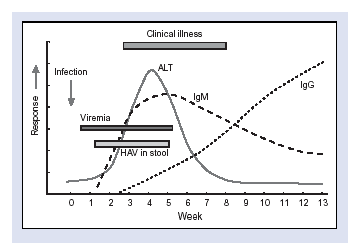The Foodhandler
Obviously, Lenny is not a stickler for details. It appears that his employees do a lot of "hands on" food preparation, but there is little evidence that handwashing is stressed, and they don't appear to wear gloves, either.
After the inspection, Barstow gets a phone call from the Department of Public Health in Mansfield, one of the adjacent towns. He learns that a physician reported a case of hepatitis A in a patient, James R., who had become ill on April 14, 2005. The patient told the physician that he went to the emergency room at the Sparta Hospital on April 14, because of nausea, vomiting and diarrhea, but they made him wait a long time to be seen. He had been drinking and was impatient. He was eventually seen by a physician, who wanted to order blood tests, but the patient became agitated and didn't want to wait , so he signed himself out of the emergency room. He continued to be ill, however, and eventually went to a physician in Mansfield, where he lives; blood tests were now done and showed a positive IgM anti-HAV. The board of health in Mansfield notified the Sparta board of health because the patient admitted to his physician that he had worked at Lenny's Bakery.
Go back and re-examine the initial line listing and locate James R. based on the date of onset of his symptoms.

That afternoon you and Barstow return to Lenny's to ask about James R.
Lenny admits that James had worked the night shift intermittently, but that he hadn't seen him for a while, and he had forgotten about James. When you interview the bakery workers, one of James's co-workers on the night shift says that James R. used to do a lot of icing and glazing of pastries, and he frequently did this with his bare hands. Later that afternoon you interview James R., who admits that, "Sometimes I was a little careless about following the proper procedures."
You explain that you are giving immune globulin to contacts of all the cases.

Contacts and the Period of Infectivity
As the image below indicates, once an individual becomes infected with hepatitis A, they begin shedding the virus into their stool 1 to 2 weeks before the onset of symptoms and for at least a week after the onset of illness.

This means that there is about a three week period during which an infected person may transmit the virus to others if proper precautions are not followed.






